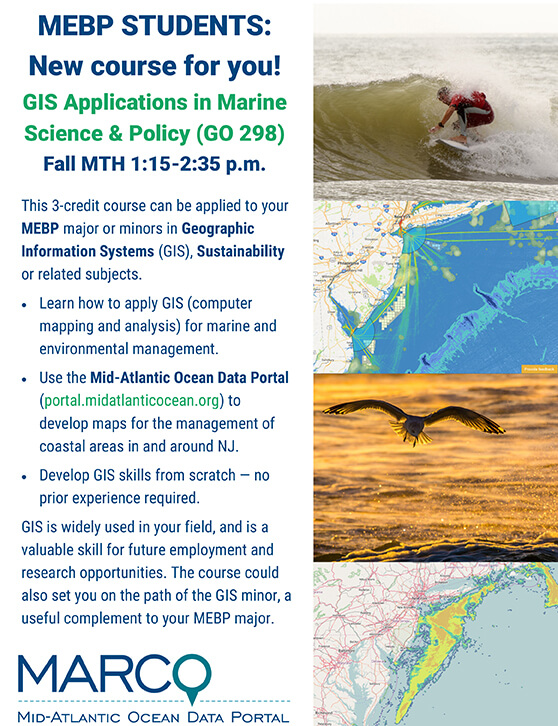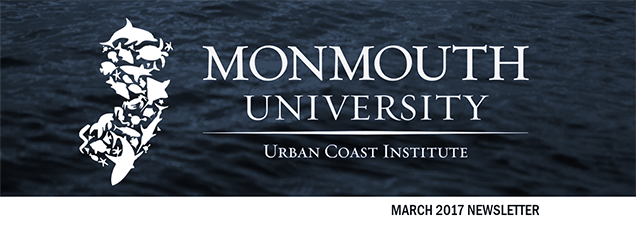
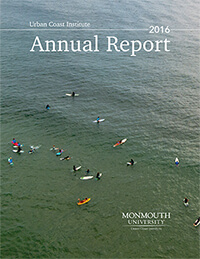
Read the UCI 2016 Annual Report
Take a look back at the eventful year that was in the Urban Coast Institute’s 2016 Annual Report. Learn about our innovative student-faculty research activities, coastal resilience initiatives, educational events, ocean exploration and planning work, and so much more.
Free UCI Spring Film Series: A Plastic Ocean, Ocean Frontiers III, Les Saisons
The Urban Coast Institute invites the public to enjoy its free on-campus Spring Film Series, featuring three documentaries and expert discussions exploring nature and issues impacting coastal ecosystems. All events are free and will be held in the Pozycki Hall Auditorium.
The UCI Spring Film Series will kick off on March 30 at 6 p.m., when UCI partners with Clean Ocean Action to present
A Plastic Ocean, an acclaimed film that is raising awareness about the consequences of society’s global disposable lifestyle. The film will be followed by a discussion with Bayshore Recycling Vice President of Operations Gary Sondermeyer, who will provide an important and interesting perspective on controlling plastic waste and marine debris.
The April 6 film Ocean Frontiers III: Leaders in Ocean Stewardship & the New Blue Economy tells the story of the Northeast and Mid-Atlantic regional ocean plans and chronicles efforts to plan for a healthy, safe, sustainable future. At the film’s conclusion, UCI Director Tony MacDonald will moderate an expert panel focused on the historic new Mid-Atlantic Regional Ocean Action Plan, which the UCI played a key role in developing. The film screening will begin at 6:30 p.m. with a reception at 6 p.m. The UCI will co-sponsor a second showing on April 22 at 7 p.m. at the Ship Bottom Volunteer Firehouse.
On April 13 at 4:30 p.m., the UCI Film Series concludes with a showing of Les Saisons (Seasons), a French documentary that explores the evolution of European forests and wildlife with exceptional high-definition footage. The film will be introduced by Rockefeller University Professor Jesse Ausubel, who served as a science advisor to the film’s directors.
See below for registration instructions and further information on each film. Light refreshments will be served. For more information, email Karl Vilacoba at
kvilacob@monmouth.edu.
A Plastic Ocean
Thursday, March 30, 6 p.m.
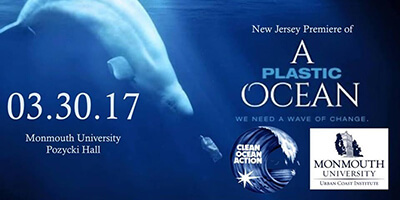 Movie Trailer: youtu.be/6zrn4-FfbXw
Movie Trailer: youtu.be/6zrn4-FfbXw
Register & More Info: coaplasticocean.eventbrite.com
Description: In A Plastic Ocean, an international team of adventurers, researchers, and ocean ambassadors go on a mission around the globe to uncover the shocking truth about what is truly lurking beneath the surface of our seemingly pristine Ocean. The result will astound viewers-just as it did our adventurers-who captured never-before-seen images of marine life, plastic pollution, and its ultimate consequences for human health. During its four-year production period, A Plastic Ocean was filmed in 20 locations around the world in beautiful and chilling detail to document the global effects of plastic pollution-and introduce workable technology and policy solutions that can, if implemented in time, change things for the better.
Ocean Frontiers III: Leaders in Ocean Stewardship & the New Blue Economy
Thursday, April 6, Reception 6 p.m. | Film 6:30 | Panel Q&A 7:30 p.m.
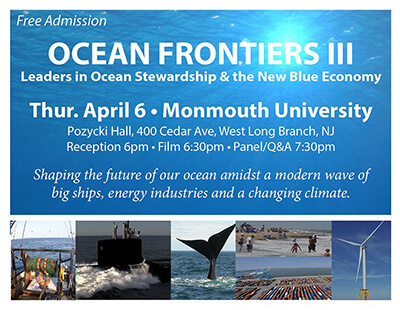
Movie Trailer: youtu.be/RRSVQ__OFFc
Register & More Info: http://bit.ly/OF3-Monmouth
Description: Ocean Frontiers III is a truly unique and hopeful ocean film that explores the intersection of national security, marine commerce and conservation. Savor rare underwater footage of stunning marine life along the coast from Virginia to Maine and hear from a range of people who are leading the way to a sustainable and thriving ocean. Participate in the post-film conversation about the new Mid-Atlantic Ocean Action plan and get your questions answered by an expert panel that includes Tim Dillingham, Executive Director, American Littoral Society; Tom Fote, legislative chair of the Jersey Coast Anglers Association and NJ State Federation of Sportsmen’s Clubs; Tony MacDonald, Director, Monmouth University Urban Coast Institute (moderator); and others TBD. This event is hosted by the Urban Coast Institute with the American Littoral Society, New Jersey Sea Grant Consortium, Association of New Jersey Environmental Commissions, Surfrider Foundation – Jersey Shore Chapter, The Nature Conservancy – New Jersey Chapter and Green Fire Productions.
Les Saisons (Seasons)
Thursday, April 13, 4:30 p.m.
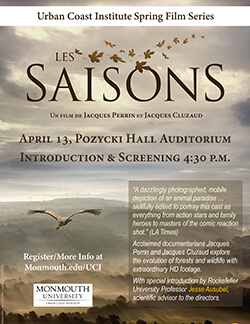
Movie Trailer: youtu.be/STOVCLb62e0
Register & More Info: http://bit.ly/2mwQlAa
Description: After traveling the world alongside migrating birds and diving the oceans in the acclaimed nature documentaries Winged Migrations and
Oceans, Jacques Perrin and Jacques Cluzaud return to the lush green forests that emerged across Europe following the last Ice Age. Winter had gone on for 80,000 years when, in a short period of time the ice retreated, the landscape metamorphosed, the cycle of seasons was established and the beasts occupied their new kingdom. Les Saisons, with its exceptional footage of animals in the wild, is the awe-inspiring and thought-provoking tale of the long shared history that binds humankind with the natural world. The film will be introduced by Rockefeller University Professor Jesse Ausubel, who served as a science advisor to Les Saisons’ directors.
UCI’s MacDonald Joins Team Researching How Chemical Cues Influence Marine Life Habitat Selection on Coral Reefs in Belize
What makes fish feel at home around healthy coral reefs and avoid degraded ones? Urban Coast Institute Director Tony MacDonald has joined a research team dedicated to understanding the chemical cues that influence how fishes, corals and other organisms select a reef habitat.
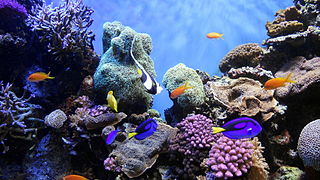
The project is being led by the University of Delaware’s Danielle Dixson with the support of a $1 million grant from the Gordon and Betty Moore Foundation. Additional collaborators include Valerie Paul, a natural products chemist and lead scientist at the Smithsonian Marine Station and director of the Carrie Bow Cay field station in Belize; and Jay Odell, Mid-Atlantic marine program director at The Nature Conservancy in Virginia.
Previous research by Dixson demonstrated that fish can tell the difference between healthy and degraded reefs, and that degraded reefs produce a chemical cue that repels fishes and corals.
The researchers will conduct surveys during high recruitment periods at the Smithsonian Institution’s Carrie Bow Cay research station in Belize and record the composition of the benthic communities (coral, algae, sand), as well as what fish and other reef creatures – and their predators – recruit to these communities. The data will provide a picture of what is different on high recruitment reefs and low recruitment reefs. Armed with this information, the researchers will perform chemical tests to determine the source of positive or negative cues.
MacDonald and Odell will focus on how the chemical cues data could potentially be incorporated in digital mapping tools that will help inform reef conservation management decisions and ocean planning. They will work with the researchers to determine how their work may be transferred to other regions, particularly in the Mid-Atlantic region. The UCI is currently leading the development of the Mid-Atlantic Ocean Data Portal (portal.midatlanticocean.org), a free, state-of-the-art mapping and information site focused on ocean areas from New York through Virginia. Odell serves as the technical lead on the Portal project, and was recognized by the UCI with a Regional Champion of the Ocean award in 2015.
“This is an exciting opportunity to work with a team of innovative scientists on research that could impact coral preservation around the world,” MacDonald said. “The data gathered through this project will be used to develop more effective marine management and ocean planning strategies.”
Research at the Carrie Bow Cay facility will take place beginning this summer. The project is scheduled for completion in the fall of 2019.
Apply Now for UCI Student-Faculty Summer Research Funding
The Urban Coast Institute is now accepting proposals for student-faculty research projects through its Marine Science and Policy Initiative and Heidi Lynn Sculthorpe Summer Research Program.

Funding is available to support activities by faculty and students from any school or department at Monmouth University, and interdisciplinary projects are encouraged. Projects must further one or more of the Core Elements of the Monmouth University Strategic Plan, as well as the mission and goals of the UCI.
There are currently three types of funding opportunities available:
Summer Research Grants for research projects (i) proposed by students with the support of a faculty mentor; and (ii) proposed by a faculty member that enables students to conduct the research and provide other project support.
Faculty Enrichment Grants to support MU and/or MU faculty collaboration for enhancement of existing curriculum, new curriculum development, research and scholarship, and team-teaching opportunities.
Mini-Grants available to faculty and students for conference fees, symposia, guest speaker honoraria, equipment and supplies to supplement or develop course curricula or course-related activities, and other needs to be determined on a case-by-case-basis.
Applications can be submitted online by April 17 through the MyMU Portal. Read more information about these opportunities and submit an application.
Surge in Sturgeon? MU Researchers Track Endangered Fish in Sandy Hook Bay and Beyond
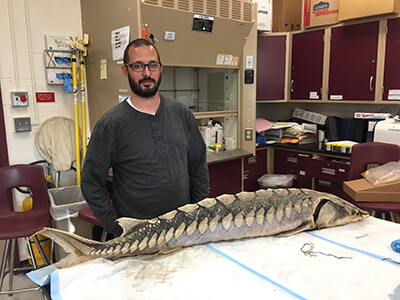
Once overfished to the point of near extinction, endangered Atlantic sturgeon are sometimes found in large numbers in the Mid-Atlantic and Northeast, although much remains unknown about their populations and behaviors. Now Monmouth University Assistant Professor Dr. Keith Dunton and students at the School of Science are working to build a greater understanding of one of the oldest fish species in the world.
With funding support from the Urban Coast Institute’s Marine Science & Policy Initiative, Dunton and his students launched a series of research projects in the summer to explore the presence, migration patterns and diets of sturgeon in the Sandy Hook Bay and surrounding waters. Most recently, Dunton acquired permission from the U.S. Department of Defense to attach acoustic receivers to buoys in the restricted waters off Naval Weapons Station Earle. Dunton described the equipment as “an E-ZPass system for fish” that records each time tagged fish move in or out of the area. The readings will add to a body of data being collected by research partners in the ocean, coastal rivers and estuaries throughout New York and New Jersey.
Dunton is a leading expert on Atlantic sturgeon, having begun his research on the species in the early 2000s while at Stony Brook University. He presented his findings at a Jan. 6 Northeast Fisheries Observer Day held at Monmouth University by the UCI, MU Biology Department, Northeast Fisheries Observer Program and Northeast Fisheries Science Center.
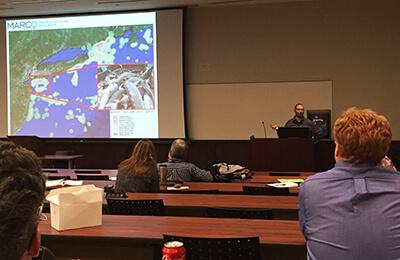
With their bony-plated bodies, whiskers and long snouts, Atlantic sturgeon have one of the more distinct appearances of fish in the region. The fish have been estimated to live up to 60 years and weigh as much as 800 pounds. Atlantic sturgeon were plentiful along the East Coast in the late 1800s and early 1900s, when they were in high demand as sources of caviar and their fleshy meat, once referred to as “Albany beef” for its popularity among Hudson Riverites. Eventually, sturgeon effectively vanished in the region and fishermen quit seeking them. The 1980s saw a brief reemergence in commercial sturgeon fishing in the New York Bight until they were placed off limits in 1996.
Atlantic sturgeon were listed as endangered in 2012. Currently bycatch is one of the biggest threats to Atlantic sturgeon recovery. Dunton’s research indicates that they are being caught most frequently by gillnetters seeking monkfish and trawlers seeking flounder. He said 90 percent of captures are taking place very close to shore, especially in the area of the Rockaways in western Long Island, where they like to feed before migrating into the bays and rivers. In his presentation, Dunton showed the audience a recent photo of a large aggregation of sturgeon caught while targeting them for research in the New York Bight. These aggregations occur yearly and vary seasonally, indicating that spatial and temporal management can be implemented.
“These aggregations raises eyebrows because if we could catch sturgeon in these numbers with so little effort, commercial fishermen can too,” he said. “We’re working with the industry, such as the monkfish fishery, to tag them and figure out some adjustments to the nets that will reduce bycatch.”
So far, Dunton said his Sandy Hook research has detected “a fair amount” of sturgeon. It appears the fish like the area’s shallow tidal waters, but tend to steer clear when the bay heats up at the summer’s peak. Dunton and his students will continue to collect data to monitor sturgeon in the day throughout the colder winter and spring months ahead.
Monmouth University student-faculty research supported by the UCI’s Marine Science & Policy Initiative is made possible through the generous support of Santander Bank and many other corporate and private donors. If you would like to make a tax-deductible gift to the Urban Coast Institute, please use our Give a Gift Now contribution form.
A Day in the Life: The F/V Christian and Alexa
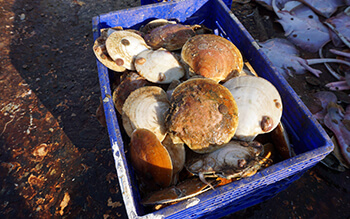
The owners of the Point Pleasant fishing vessel Christian and Alexa recently welcomed the UCI’s Karl Vilacoba aboard to observe a typical day at sea for this Ocean Stories feature on the Mid-Atlantic Ocean Data Portal. Follow along with Karl’s trip diary and learn how scallops make it from the sea bed to your grocery store. Be sure to watch the Portal’s signature scrolling data maps above for scientific insights on the journey.
Fairleigh S. Dickinson, Jr. Foundation Grant to Support UCI Vessel Activities
The Fairleigh S. Dickinson, Jr. Foundation (FDF) has awarded the UCI a $75,000 grant that will support safe operation of UCI research vessels and provide students in Monmouth University’s Marine and Environmental Biology and Policy Program with new opportunities for field-based research and experiential learning.
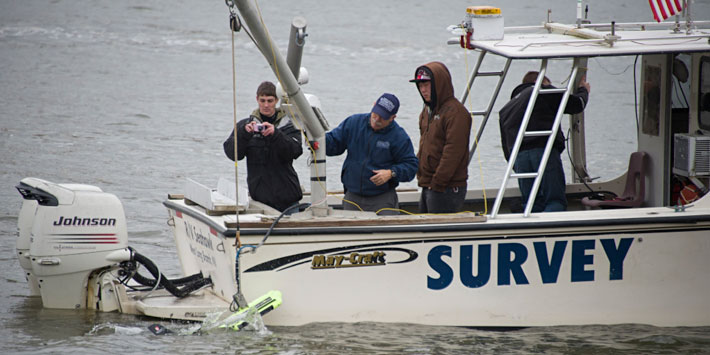
The funds will be used to support marine field research and cruises in connection with academic courses, independent study and faculty and student research projects. Students will be given experience with state-of-the-art technology and research methods while assuring vessel readiness and safe operations to support their work.
“The Fairleigh S. Dickinson, Jr. Foundation has been instrumental in supporting the UCI at critical points over the years to enable us to initiate programs in water quality testing along the Jersey Shore and increase understanding of water quality and flood warning systems, and to train students on the use of remotely operated underwater vehicles and other marine technology,” said UCI Director Tony MacDonald. “This support will provide students with a truly transformational learning experience, and further advance the UCI’s mission to develop the best available science to support healthy and productive coastal ecosystems and a sustainable communities.”
The University currently maintains two vessels and is looking to expand its capacity. The vessels provide research platforms for the use of a remotely operated underwater vehicle (ROV) purchased with previous FDF funding, as well as side-scan sonar, water quality monitoring and testing, trawling, plankton tows, deployment of water current meters among other activities.
UCI Marine Scientist Jim Nickels specifically developed a course — Field Research Methods in Marine Science – to train students in field methods using this equipment. The vessels also provide direct support for a number of other courses including Oceanography, Biological Oceanography, Ecosystems Analysis, Marine Biology and Marine Archeology.
See more information on the UCI’s vessels, equipment and field activities.
Final Report Released from 2016 National Ocean Exploration Forum
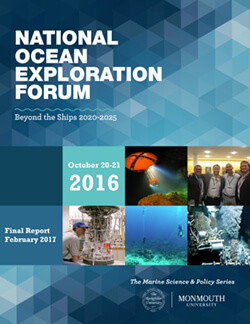
Ocean explorers need to think “beyond the ships” and plan ahead to an age of SuBastian and the Roboats – a new world of marine technology characterized by autonomy, sensors, precision, miniaturization, machine learning and artificial intelligence, telepresence, better forms of energy storage, and sharing to boost asset utilization. That’s among the major recommendations emerging from the 2016 National Ocean Exploration Forum, “Beyond the Ships: 2020-2025,” delivered in a final report released Feb. 20.
Hosted Oct. 20-21 by the Program for the Human Environment at The Rockefeller University, New York City, in partnership with the Monmouth University Urban Coast Institute, the Forum was the latest in a series mandated by Congress in 2009 to promote ocean exploration and its attendant cooperative expedition planning, technology development and transfer, data management, and public understanding. About 100 influential academic, government, and private sector experts discussed adaptation and integration of technologies to employ in ocean exploration campaigns in the 2020-2025 timeframe.
The top recommendations:
- Understand better the U.S. “demand” for exploration.
- Think and plan “Beyond the Ships,” to the world of SuBastian and the Roboats, and therefore continually develop autonomy, lower cost sensors and vehicles, miniaturization, machine learning and artificial intelligence, telepresence, better forms of energy storage, and sharing to boost asset utilization.
- Allow many more oceanographic vessels to become vessels of ocean exploration by two technology-related actions that can be taken almost immediately:
- a) outfit vessels with telepresence communications capabilities; an
b) modularize deep ROV and other exploration sensor systems in air/ship moveable containers.
- a) outfit vessels with telepresence communications capabilities; an
- Support development of environmentally responsible disposable exploration sensors and devices, including vehicles.
- Promote new, nondestructive means of collecting biological samples, especially techniques that do not harm or destroy a marine species when the sample is brought to the surface, and techniques that non-destructively collect a sample of biomaterial from the organism in situ, or the water around it.
- Use campaigns as systematic “proving grounds” for emerging ocean exploration technologies.
- Embrace the “campaign” concept so that a larger fraction of U.S. national ocean exploration is conducted as campaigns. Supported by several sponsors (public and private) using a multitude of techniques, “campaigns” comprehensively explore an ocean area and may span several years.
- Develop better measures and indicators for whether an ocean area is explored and characterized.
- Speed “the baseline” exploration activity to map the U.S. EEZ comprehensively with multibeam bathymetry at appropriate resolution.
- Embrace an international goal to map the entire ocean, the General Bathymetric Chart of the Oceans.
The 34-page final report is available in full at phe.rockefeller.edu/noef/NOEF_Report_0217.pdf. A wealth of additional materials from the forum have been posted at the updated site phe.rockefeller.edu/noef/.
The forum was supported by the Monmouth-Rockefeller Marine Science and Policy Initiative, the National Oceanic and Atmospheric Administration, the Schmidt Ocean Institute and James A. Austin, Jr.
UCI Director Tony MacDonald Statement on JOCI Ocean Action Agenda
Urban Coast Institute (UCI) Director Tony MacDonald issued the following statement on the release of the Joint Ocean Commission Initiative’s (JOCI) Ocean Action Agenda. The report was developed with input from the UCI and JOCI Leadership Council members Monmouth University President Emeritus Vice Admiral (ret.) Paul Gaffney, UCI Ocean Policy Fellow, and former UCI Advisory Committee Member Mrs. Lillian Borrone.
“Administrations may change but the ocean will continue to play a critical role in regulating weather, supporting productive fisheries and other natural resources. As recognized in the JOCI Ocean Action Agenda, investment in our coast and oceans will also sustain a growing economy ranging from ports and trade to offshore wind energy to travel and tourism. It is encouraging to see the consensus report and call-to-action from a bipartisan group of nationally respected leaders. JOCI Co-Chair Gov. Christine Todd Whitman was joined by JOCI member Dr. Donald Boesch at Monmouth University in December for the
2016 Future of the Ocean Symposium, where they made similar recommendations and were honored as National and Regional Ocean Champions.
The Ocean Action Agenda sets out concrete actions that will strengthen regional collaboration among states and federal agencies in the Mid-Atlantic, including continued support for the
Mid-Atlantic Ocean Data Portal that has been a major focus of the UCI’s work over the past four years. The report expresses strong support for basing ocean management and policy decisions on the best available science. The UCI shares that commitment and looks forward to working with the Trump Administration and Congress, and our local and regional partner to support implementation of the Ocean Action Agenda.
In addition to Gov. Whitman and Dr. Boesch, the JOCI Leadership Council includes three other members who have been recognized by the UCI with our annual Ocean Champions award: The Hon. Leon Panetta, Dr. Robert Gagosian and Mrs. Lillian Borrone.”
From a Pier Seared to Pier Village: Panel Recounts Eminent Domain’s Role in Long Branch Waterfront Revival
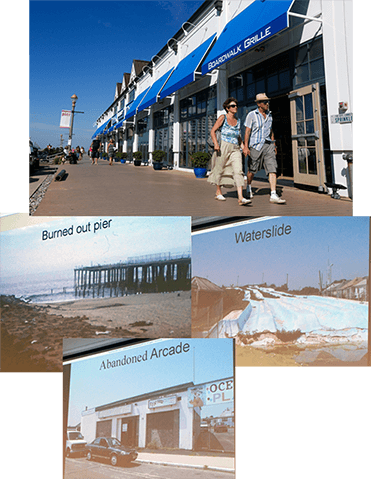
On an idyllic summer night in 2008, Long Branch Mayor Adam Schneider soaked in the energy from the bustling crowd and vibrant new Pier Village buildings that surrounded him and made a decision: It was time to end a long court battle that become a focal point in the national debate over the appropriate use of eminent domain by local governments. His city had already come as far as he could have hoped for.
The mixed-use Pier Village and Beachfront North developments were by that point drawing hundreds of thousands of tourists each summer. Just a few years earlier, Schneider daydreamed about smashing the neighborhood’s pay phones with a baseball bat because they were such magnets for drug dealers. The Long Branch waterfront, like the fire-ravaged pier that remained there, had largely become an abandoned and unsafe eyesore.
“You wouldn’t walk my beach back then,” he said. “Our beach revenues were not even $200,000. Last year they were over $2 million.”
The journey between those two extremes was recounted on Feb. 10 by a panel consisting of Schneider, K. Hovnanian Vice President David Fisher and moderator Peter Reinhart, Director of Monmouth University’s Kislak Real Estate Institute. The discussion was one of several facilitated during an Eminent Domain and the City conference co-sponsored by the University’s Department of History and Anthropology, Kislak Real Estate Institute, Leon Hess Business School, Urban Coast Institute and Wayne D. McMurray School of Humanities and Social Sciences.
The conference examined the economic, political, environmental, social and cultural impacts of the use of eminent domain, particularly on cities trying to revitalize themselves. Speakers presented a range of philosophical and historical perspectives on the issue, as well as case studies from around the world, including New Jersey, Philadelphia, Baltimore, Massachusetts and Italy.
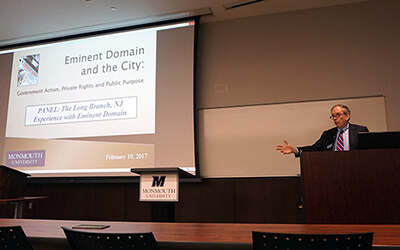
Reinhart (seen right) led off the Long Branch discussion by cycling through a series of before and after photos showing the transformation of the beach area from the early 1990s to today. The waterfront’s downward slide accelerated after 1987, when a haunted house amusement on the city’s pier caught fire and destroyed the outer portion of the structure. Other businesses along the boardwalk, such as a waterslide park and arcade, failed soon after. Some homes in the area were boarded up while others deteriorated as rental properties controlled by absentee landlords.
In the early 1990s, the city designated portions of the waterfront as areas in need of redevelopment and began working with a public-private consortium called Long Branch Tomorrow to reimagine and revitalize the beach district. Schneider recalled that a significant obstacle to progress was the fact that the areas were comprised of hundreds of small properties with different owners. An added challenge was satisfying Coastal Area Facility Review Act (CAFRA) guidelines that raised the bar in terms of designing projects that provided the utmost public access to the beach. The city used its eminent domain powers to help consolidate the many tracts into a handful of larger areas that could be redeveloped with large-scale, comprehensive plans.
In the first phases of redevelopment, the city encountered little resistance with its use of eminent domain, which Fisher said was only required for a few properties. However, during a later stage of the process, a group of homeowners that came to be known as MTOTSA (an acronym for the Marine Terrace-Ocean Terrace-Seaview Avenue streets where they lived) declined to sell their homes and fought the city’s use of eminent domain in court. Many criticized the city’s willingness to seize properties from one private owner to transfer them to another.
After a series of court rulings that seesawed in favor of each side, the city and developer decided to move on. The developer worked with some willing sellers to build individual new homes on their properties rather than replicating the high-rise condos at the adjoining Beachfront North. By then, Fisher said, the success of the first projects had increased property values so much that redeveloping individual lots was no longer profitable.
Looking back, Schneider, who has served as mayor for 27 years, said he has no regrets about his administration’s use of eminent domain.
“Whatever political capital I spent doing it, it’s better than to have been the caretaker of a declining city,” he said.
Learn to Use Mid-Atlantic Ocean Data Portal in New Monmouth U. Course
Monmouth University students – learn to use the Mid-Atlantic Ocean Data Portal to make ocean management decisions in this new fall course! The UCI is proud to serve as the project lead among a great team of partner organizations developing this rapidly growing and influential resource. Try it yourself at portal.midatlanticocean.org.
